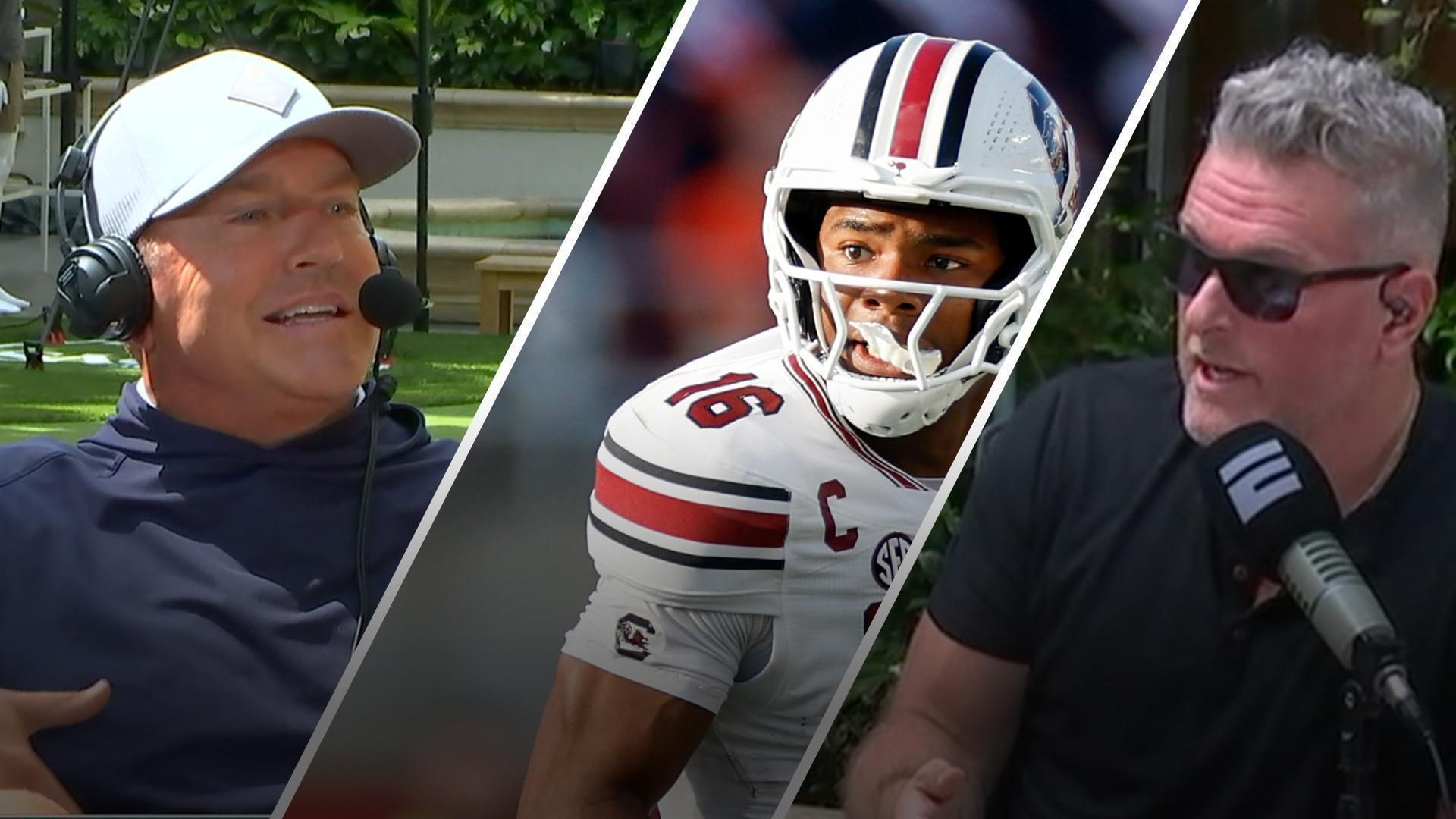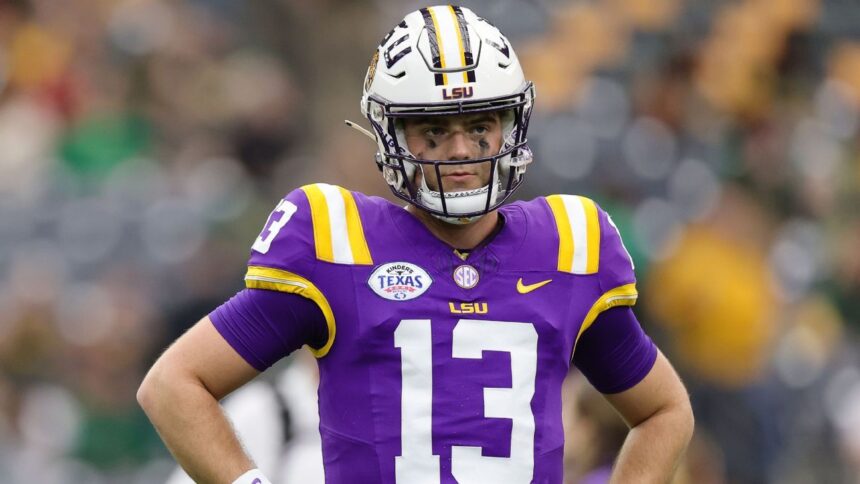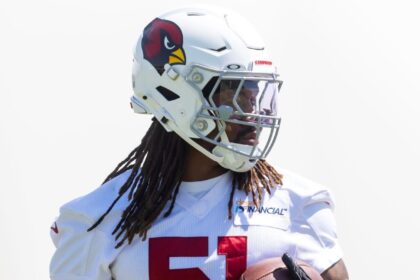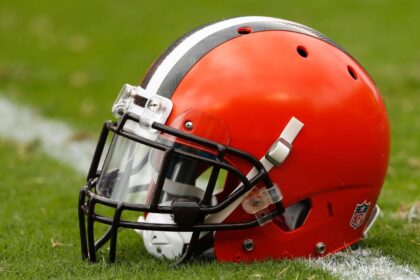NFL Draft 2026: Early Moves and Key Perspectives
Although there is still time until the start of the 2026 NFL Draft, teams are already outlining their strategies. At Alofoke Deportes, we delve into the initial panorama, analyzing the most outstanding players by position and the projections of the experts. This analysis is based on a thorough study of the prospects and conversations with scouts and NFL executives. The goal is to answer key questions: Who leads the most contested positions? What offensive talents are seen as the most promising? In addition, we will address the Arch Manning phenomenon and his possible participation in the draft.We start with the quarterbacks, where several quarterbacks compete to be number one.
Quarterbacks
Cade Klubnik (Clemson) vs. Garrett Nussmeier (LSU)
Before we delve deeper, let’s talk about Arch Manning. The Texas quarterback is one of the most talked-about names in college football, despite having only two starts. Although he is a promising talent, he has not yet proven himself ready for the NFL. Scouts agree that Manning will not leave Texas after the 2025 season, regardless of the team’s success. Regarding the other quarterbacks, for the second consecutive year, there isn’t a clear QB1 at the start of the season. Although this class doesn’t have a prospect that generates the same expectation as Caleb Williams or Trevor Lawrence, we can’t forget the rise of Jayden Daniels and Cameron Ward in consecutive seasons. Scouts are watching emerging players like Fernando Mendoza from Indiana and LaNorris Sellers from South Carolina, but the main current quarterbacks play in the south. Klubnik had a great season finale. The 6-foot-2-inch, 210-pound passer is smart and can shred defenses when he gets into a rhythm, as he demonstrated against Texas in the College Football Playoff, throwing for 336 yards and three touchdowns. Klubnik finished the season with 36 touchdown passes and six interceptions, a significant improvement over his 19-9 ratio in 2023.
On August 30th, these two quarterbacks will face off in Clemson, a match that everyone will be watching.Nussmeier excites me the most because he is very precise and quick in decision-making.
An AFC East scout
Klubnik needs to prove he can elevate that offense consistently and not just be a game manager.
An AFC South scout
The competition is open. For now, Klubnik is our choice, but we are excited to see Mendoza and Sellers in action.Nussmeier has a more powerful arm, he is more dynamic as a runner and his potential is greater.
An NFC West scout
Our initial QB choice: Klubnik
Running Backs
Jeremiyah Love (Notre Dame) vs. Nicholas Singleton (Penn State)The 2026 running back class promises to be exciting, led by a Notre Dame running back coming off a 17-touchdown season. However, he could face tough competition for the RB1 spot. Love returns to South Bend after a season of 1,125 yards, although a knee injury limited his performance in the last three games. His 98-yard run against Indiana in the College Football Playoff quarterfinals demonstrated his vision, power, and explosiveness. Now, fully recovered, Love has the potential to be an elite prospect in the NFL.The RB2 is debatable, thanks to a large number of talented running backs, many of them forming strong duos. Texas has Quintrevion Wisner and CJ Baxter, while Penn State’s pair, Singleton and Kaytron Allen, aims to be the 2025 version of Ohio State’s Quinshon Judkins and TreVeyon Henderson. Singleton looks poised to excel thanks to his complete game. At 6 feet and 227 pounds, the senior has plenty of strength and the speed to outmaneuver defenders. He’s also versatile, with 41 receptions for five touchdowns last season.Love is by far the best quarterback in the class. Probably in college football in general.
An NFL general manager
Love is the man, but Singleton could be an unexpected RB1 for teams looking for power and dynamism, but value the passing game.
A former NFL general manager
Our initial RB choice: Love
Wide Receivers
Makai Lemon (USC) vs. Jordyn Tyson (Arizona State)
If you think we are living a golden age for receivers, you are not mistaken. After seeing another receiver selected in the top 10 last year, we might have a pause in 2026, unless there is a very successful season. There are several candidates to be that player, and the discussion begins with Tyson, thanks to his skills and the situation surrounding him. At 6-1 and 195 pounds, Tyson is a deep receiver who caught 75 passes for 1,101 yards and 10 touchdowns.Tyson’s biggest problem? Ball drops. He had seven last season and must improve to reach WR1 status.
Lemon, at 5-11 and 190 pounds, showed flashes with 52 receptions, 764 yards, and 3 touchdowns in 2024, but both he and the USC offense were inconsistent. That hasn’t stopped scouts from praising what he could become in 2025. Lemon is my bet for a breakout player.An NFC South scoutFor now, Tyson is the choice, but Lemon and other players like Isaiah Horton (Alabama), Antonio Williams (Clemson), Eric Singleton Jr (Auburn), Denzel Boston (Washington), and Elijah Sarratt (Indiana) are also contenders.Tyson makes the most difficult catches look easy and the easiest, difficult.
A Big 12 rival coach
Our initial WR choice: Tyson
Tight Ends
Eli Stowers (Vanderbilt) vs. Kenyon Sadiq (Oregon)The 2025 draft saw two tight ends selected in the top 14 and five in the top 50, marking another strong year for the position. Although we are unlikely to see two tight ends selected so early in 2026, the class should have many talents in the top 100.
Leading the class is Stowers. At 6-4 and 225 pounds, he might not have the traditional size of a tight end, but he has elite route-running ability and offers flexibility in his alignments. A creative team can use Stowers in any position, from H-back to wide receiver. Scouts are divided on his ideal use, and doubts remain about his ability to win against top-tier teams.Others adore Stowers’ versatility, with an NFC South scout calling him the “undisputed TE1 in this class”. With the success of Terrance Ferguson last season, Oregon’s offense is becoming a sort of conduit of tight ends to the NFL. Next up is Sadiq, a 6-3, 245-pound junior who showed potential last season by catching two touchdowns on 24 receptions as the team’s number 2 tight end. Sadiq’s experience as a receiver in high school is evident in his route running, and he is too fast for most linebackers or safeties.It’s like Harold Fannin Jr. last year. A small guy with good skills, but he disappears when pressured, and doesn’t fit into many schemes. He’s just a slot player. He’ll never play on the line of scrimmage.
An AFC West scout
It’s a tough battle between two very different players, but Stowers’ resume gives him the initial advantage.If you want a breakout player, it’s Sadiq. Especially with Evan Stewart injured, Sadiq is ready to explode.
An AFC West scout
Our initial choice for TE: Stowers
Offensive Tackles
Spencer Fano (Utah) vs. Kadyn Proctor (Alabama) vs. Francis Mauigoa (Miami)
In April, we saw three offensive tackles selected in the top 10, but the 2026 class could have even more talent. These three are the headliners of an exciting group.The first of those tackles is Fano. An elite run blocker, Fano has played left and right tackle for the Utes. At 6-6 and 302 pounds, he has the balance and agility to dominate the edge of an NFL offensive line, even if there are already rumors about arm length issues. Fano, who has started 24 games, saw his sacks allowed decrease from three in 2023 to just one in 2024, when switching from the left to the right side. Proctor is the biggest (6-7, 360 pounds) and strongest of the group, and the player scouts have the most expectations for if he can reach his potential. He has the ability to subdue defenders in a way that no other tackle in the class can. Proctor’s evolution as a tackle prospect during the second half of the 2024 season has made scouts think he has turned a corner.I loved last year’s class, but each of the big dogs were players who could be long-term guards. This year? We have real tackles.
An NFL general manager
We can’t forget about Mauigoa as a potential top tackle. In a way, he’s very similar to Armand Membou in terms of agility and movement skills. A starter for two years at right tackle, Mauigoa didn’t allow any sacks and was only penalized three times last season while protecting the number 1 pick of 2025, Cameron Ward. Perhaps most impressive was Mauigoa’s missed block rate of 0.06%, only two missed blocks in 13 games.If you see him against Georgia or South Carolina, two teams with great defensive lines, he seemed like a top-five pick.
An AFC South scout
These three represent the best of the class, but there are others that scouts are excited to see. Evaluators also mentioned Xavier Chaplin (Auburn), Drew Shelton (Penn State), and Isaiah World (Oregon) as potential number 1 tackles. Proctor could lead the group right now, but this is a diverse class of tackles with many possible risers.
Our initial choice for OT: Proctor
Interior Offensive Linemen
Cayden Green (Missouri) vs. Jake Slaughter (Florida)
A battle for the top interior offensive line spot of the class will be fun between two very talented players. Missouri developed Membou into a top-10 draft pick in 2025, and sources within the coaching staff have the same expectations for Green entering 2025. The 6-5, 320-pound lineman begins the season as a two-year starter at left guard, and there has been some internal discussion about moving him to left tackle due to his agility and tools. Green did not allow a sack last season. Slaughter has the opportunity to be the best run and pass blocker among the interior linemen in the class thanks to his instincts, poise, strength, and agility. At 6-4 and 308 pounds, he doesn’t have elite anchoring ability, but he moves exceptionally well and has the reach to pull, trap, and get to the second level.Slaughter and Green are talented, but Green’s versatility and resume as a pass protector give him the edge.What I love about both guys is that they will face an absolutely infernal schedule for most offensive linemen. They will be tested at the end of November, and we will have a good view of their professional capacity.
An AFC scouting director
Our initial choice for IOL: Green
Defensive Tackles
Peter Woods (Clemson) vs. Caleb Banks (Florida)
The 2026 defensive tackle class doesn’t have a great depth of elite talent or many notable playmakers. It’s basically Woods versus the rest, and he’s poised to be the top prospect.Woods, a 6-3, 315-pound junior, recorded three sacks and 17 pressures last season, proving to be a top-tier run defender. He did so while splitting time between the end and the interior, a role that often limited his pass-rushing advantages because he was expected to play in space. If unleashed on the interior, Woods has the ability to be in the top 10. Challenging him will be Banks and a group of characters waiting to stand out. Banks, at 6-6 and 329 pounds, can play anywhere from a 5-technique to a nose alignment. He performed well last season, with 4.5 sacks and 20 pressures.This is a pretty weak class. There are some guys outside of Woods, but they are nose tackle or 1-tech types. If you need a 3-tech, I hope you got him last year.
An NFC South scout
Woods seems like a safe bet as the best defensive tackle, and that’s where he’ll start on my board.Banks could be this year’s Byron Murphy II, where you see the talent and then boom, he puts it all together and is unstoppable.
An NFL defensive line coach
Our initial choice for DT: Woods
Edge Rushers
T.J. Parker (Clemson) vs. Keldric Faulk (Auburn)
The most contested battle of any position outside of quarterback occurs at edge rusher, where the talent in the 2026 class represents an exciting mix of first-round talents and very good depth. Parker had a 12-sack season in 2024, while becoming a complete career defender. His speed off the ball stands out, but scouts praised his ability to pressure the passer.Like Parker, Faulk brings a combination of speed and power at 6-6 and 288 pounds. With seven sacks last season, he proved that his skill set of length, power, and speed can produce in the SEC. Now, a big season is expected.Parker has the best tools of them all. He prepares blockers well and finishes with a mean streak. And you need power to play in the pros.
An AFC East scout
Parker, Faulk, Rueben Bain Jr. (Miami), David Bailey (Texas Tech) and others compete for the top spot in a group that could easily produce six first-round players. Right now, Parker is the best in the group.Our initial choice for Edge: ParkerFaulk is going to get Arik Armstead comparisons, but I think he’s athletic enough to stay in space in the pros. But you love that he can also get inside.
An AFC North scout
Linebackers
Anthony Hill Jr. (Texas) vs. CJ Allen (Georgia)The off-ball linebacker position has been devalued, but Hill’s versatility will have scouts talking about the next prospect at the level of Abdul Carter or Micah Parsons. A debate has arisen about Hill’s best position. In Texas, he primarily plays as an off-ball linebacker, but the 6-3, 235-pound defender produced eight sacks last season with some elite blitzing skills. In 80 plays as an edge rusher, he produced 11 pressures, and he has the type of body to add the necessary weight to play in space at the end of the line.Allen will attract the most attention from teams looking for a traditional three-down linebacker. He became a leader on the Bulldogs’ defense last season, accumulating 71 tackles, 11 pressures, 1 interception, and 7 pass deflections.Hill will definitely be recruited as an edge. He’s a great linebacker, but he’s too valuable coming off the corner and catching the quarterback. I just hope Texas lets him do more of this this year.
A veteran NFL scout
Once again, we are comparing two players who are in the same position but play it very differently. I’m going with Hill, who has the opportunity to be a top-five pick in April.Allen is a wrecking ball. That guy does it all, and he’s very quick to read and react.
An NFC South scout
Our initial choice for LB: Hill
Cornerbacks
Jermod McCoy (Tennessee) vs. Avieon Terrell (Clemson)The best cornerback in the country might not see the field at the beginning of the season, as McCoy tore his ACL during preseason training in January. The 6-foot, 193-pound defender had four interceptions last season and demonstrated the closing speed and reaction agility to shut down wide receivers, as well as being able to play the ball in the air. He has the potential to be a lockdown cornerback if he returns from injury in the same form we last saw him. Terrell, the younger brother of Falcons cornerback A.J. Terrell, has a complete game at 5-11 and 180 pounds that features speed, great ability in the running game, and elite timing. He has an ability to knock down passes at the catch point.We agree. McCoy is the number 1 cornerback until something changes.McCoy is the best in the country, but he’s an unknown to us right now. If he’s not in, Terrell is the cleanest in terms of technique, even if he’s smaller.
An NFC scouting director
Our initial choice for CB: McCoy
Safeties
Caleb Downs (Ohio State) vs. Dillon Thieneman (Oregon)
Without disrespecting Thieneman or the many other talented safeties in college football. But this one isn’t close. Downs begins the season as my top overall prospect and an uncommon talent at the safety position. A general manager told me that Downs could be a first-round pick at running back if he wanted to follow the path of Travis Hunter and play on both sides of the ball. At 6 feet and 205 pounds, Downs has the size, strength, speed, and versatility to play in the box or as a single-high defender.While Thieneman won’t challenge Downs’ position, he’s a good player. A transfer from Purdue, he was personally selected by coach Dan Lanning to lead Oregon’s defense. Thieneman is a playmaker with alignment versatility. He’s a possible first-round pick with elite ball skills and the closing speed to thrive as a free safety in Lanning’s defense. Thieneman, Michael Taaffe (Texas) and other talented safeties would be candidates for the top spot in most years, but Downs is an uncommon prospect who occupies it as the best safety and the number 1 overall player in the class.He would be a top-five safety in the NFL today if he were eligible. He’s Kyle Hamilton but faster and more explosive.
The GM
Our initial choice for S: Downs











